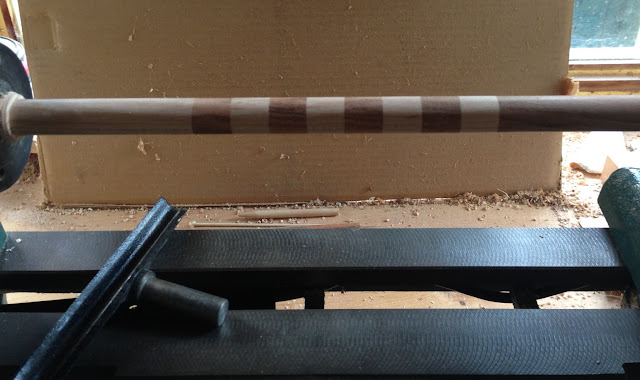The Oddblock Station has welcomed a new arrival.
Fresh out of the box a few minutes earlier and no parts missing!
Lathe levelled with wood sqaures cut and ready...
Here is another view of the same squares.
Why wait for later?
Quite a few woodchips later...
The Oddblock Station Agent
Addendum: May 19, 2013
Not yet a year later and a lot (really a lot) of wood chips later a few things have been turned out.
Addendum: September, 01, 2017
The idiosyncrasies of glued-up stock...
 |
| Soft Maine maple and black cherry matched up. |
This piece shown was turned to 3/4"
One of the exasperating challenges that turning longer thinner pieces presents is bouncing or chattering against the chisels; no matter how sharp. The results of course are tear-out or flat surfaces and often both together.
I know that stabilizers are available to address this problem, however, I've not yet been able to find one on the market that will fit my mini-lathe.
Anyway, these small pieces were glued-up like a shish-kebab on a 3/8th inch maple dowel running through. I'm not sure if that assembly helped or hindered the flexing while turning issue but I'm leaning toward the latter.
Addendum: April, 17, 2019
Going steady... but it's not what you might think.
Late last fall I finally purchased a lathe bed extension (on sale) to allow me to turn pieces slightly longer than three feet. That necessitated moving the mini lathe out of the bay window, reorganizing the space in the shed and then building a whole new table for the extended lathe which now had an overall length of 54 inches.
Just ahead of the onset of winter and cold weather, on a warmish November afternoon I tried turning a 36 inch long 1 x 1 square of red elm which I'd purchased in Rumford, Maine a few weeks earlier.
You'd think that wood as hard and heavy as red elm wouldn't bend, but as I neared the midpoint between headstock and tailstock, that piece chattered and bounced off-center so much that I couldn't rough it.
I dithered about spending any more money on more equipment and gadgets to get my wood turning to turn well, and then I discovered that Lee Valley Tools sells a lathe steady that would fit my lathe. (others on the market won't fit)
Snow and ice are finally gone and warmer days have arrived so I reopened Oddblock Station for another season.
Assembling the steady fresh out of the box was easy, but figuring out how to correctly and safely use it took a few tries over the course of an afternoon.
That's the red elm square that's no longer square.
Snow and ice are finally gone and warmer days have arrived so I reopened Oddblock Station for another season.
Assembling the steady fresh out of the box was easy, but figuring out how to correctly and safely use it took a few tries over the course of an afternoon.
That's the red elm square that's no longer square.
 |
| This heavy-looking white contraption is a lathe steady. |
Another lesson learned after getting the steady all set up and ready... make sure it's on the correct side of the tool rest support, otherwise...
Yeah! I had to take it off, move it to the other side and then get it all set up again.
 |
| Here's another view of the steady as well as the extension bed. |
Red elm is very similar to ash and oak in both hardness and grain. I don't rate them as the best of woods to choose for turnings unless chisels are razor-sharp... but try taking it for a spin.
Addendum: July 23, 2019
A few more things have turned out reasonably well. Here's a smapling











No comments:
Post a Comment